How long does a bull run last?
A bull run in the area of cryptocurrencies corresponds to a period of prolonged increase, during which prices increase in a sustained and rapid manner. By observing the past cycles of Bitcoin and other crypto-active, we see that this type of bull market can extend over several months, or even more than a year. Strong assessments often culminate by a summit known as Ath (All-Time High). In this introduction, the main idea is as follows: growth cycles generally last between 12 and 18 months for Bitcoin, while some of ltc can experience shorter or longer durations depending on their fundamentals and volatility.
Table of contents
How long does a bull run last: key factors in a bull market in cryptocurrencies
When the crypto-active market enters an exponential , it is associated with behavior called “ bull run ” or bull market . The reasons for this upward trend may include:
- An increase in demand due to the interest of institutional and private investors
- Specific events, such as Bitcoin's Block Reward Halving
- Macroeconomic conditions promoting speculation on digital assets
- The evolution of fundamentals linked to blockchain projects (use cases, adoption, update of the protocol)
- A limited circulation offer and the number of tokens available
One of the elements to understand how long a bull run is to analyze the context: market feeling, liquidity entering exchange platforms, technological innovations, as well as media attention. Each cycle, the characteristics remain similar, but the durations can differ depending on the maturity of the ecosystem and the solidity of the projects underlying growth .
How long does a bull run last: define precisely the beginning and the end of a bull run
To determine the duration of a bull run you have to wonder when it is confirmed that the market has entered the bullish phase. Several criteria are generally retained:
- The crossing of a resistance on the price of bitcoin or at ltc oins
- A sustained increase for several weeks, accompanied by large volumes
- Positive announcements or strong media craze that strengthen the feeling of market
As for the end, it is often characterized by a very rapid final increase (Blow-Off Top), followed by a brutal correction. When a new ATH is reached, but the momentum is no longer maintained, the risk of a lower (or “Bear Market”) market grows, thus marking the end of the bullish cycle. In this article, the approach consists in considering a bull run as the period from the bullish break of a key level (with increased volumes) to the absolute summit observed before a prolonged reversal.
How long is a bull run lasts: Understanding Bitcoin history and its bull market phases
Bitcoin is often taken as a reference to determine how long a bull run in the cryptosphere. Indeed, its significant capitalization and its role as “mother of cryptocurrencies” greatly influence general trends. Here is an overview of the main historic BTC bruising cycles , which often serve as a benchmark for the entire market.
2010– 2011 cycle
Duration and growth
The marking first cycle for Bitcoin began in 2010, when its price has gone from less than $ 30 dollar to dollars. The period supervised in red lasted just under 2 months (1 month and 26 days).
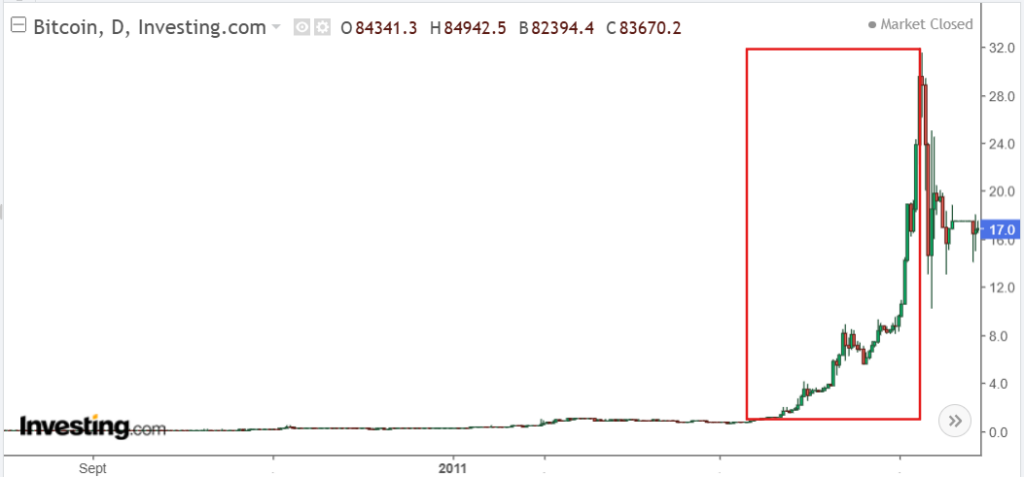
Over this period, volatility was extremely high and the market was very little liquid.
This cycle remains a case of school, because the Bitcoin price was still very low and the capitalization of the limited market. Speculation came mainly from Blockchain technology enthusiasts.
2011-2013 cycle
Duration and growth
We can start the bullish race at its lowest at 2 dollars around November 2011. From this moment, and until April 2013, Bitcoin went to more than 250 dollars.
The extreme rise period supervised in red lasted just under 3 months.
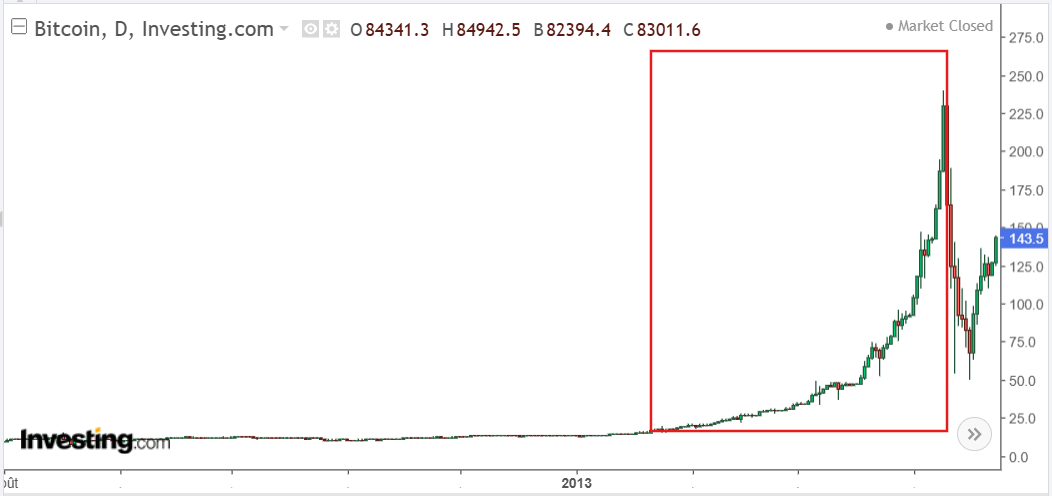
2013 - 2014 cycle
An exponential progression followed by a Bear Market
During 2013, Bitcoin experienced a spectacular flight, going from a range between $ 50 and 100 dollars to more than $ 1,000 at the end of the year. This growth spread over about 12 months with a particularly significant rise for 2 months. Many new entrants have flocked, attracted by rapid performance promises. However, at the end of 2013, the market experienced a sudden fall, marking the start of a Bear Market which lasted almost all of 2014 and a part of 2015.
- Beginning of the bull run : exceeding 100 dollars with a strong volume
- End: damage of more than 1200 dollars, followed by a rapid fall
- Duration: 2 months of solid progression
This cycle is often quoted to show that the more the capitalization of a crypto-active grows, the more the speculative attraction attracts crowds of new investors, which extends the growth phase until the saturation market.
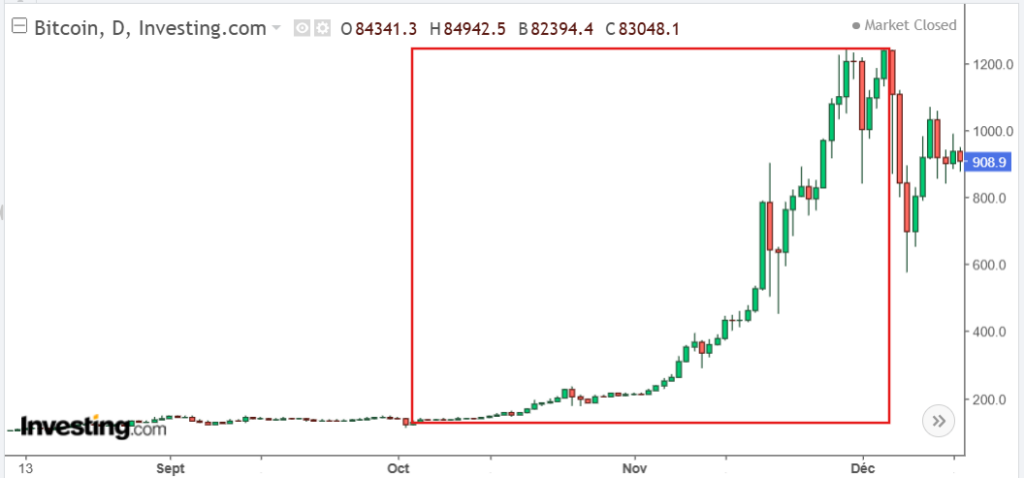
Cycle 2015 - 2017
From stagnation to the historic record in 2017
After a long lower market in 2014, Bitcoin fell around 200 dollars in early 2015. We can date the start of the new bull run when the course crossed the $ 300 area with a sustained upward dynamic, at the end of 2015. The boom accelerated in 2016 with the arrival of new capital and a renewed media interest. The real exponential increase intervened in 2017, carried by:
- Strong media coverage
- The rise of Ethereum and others at ltc OOS
- The discovery of the blockchain by institutions
- The desire for massive participation of small investors
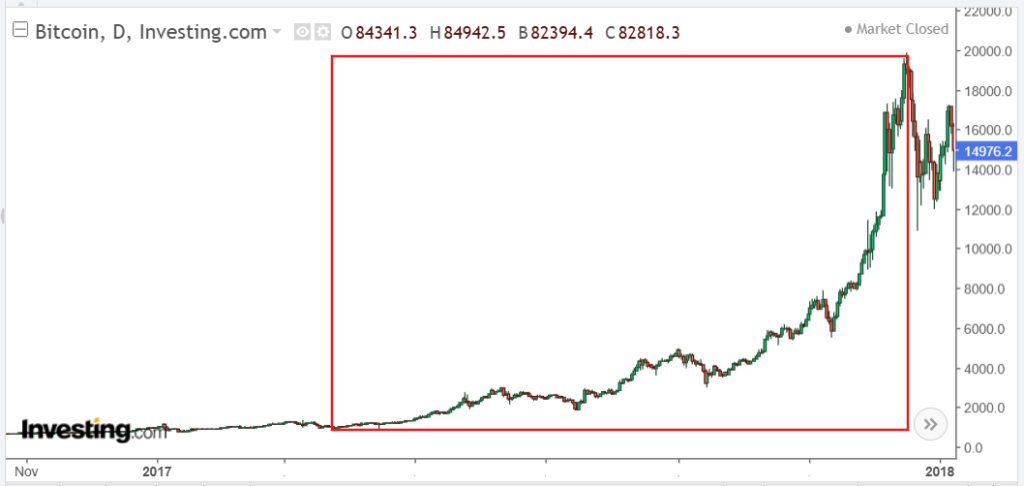
The summit culminated at nearly $ 20,000 in December 2017. On this cycle, growth, from the starting point to $ 200 up to $ 20,000, spread over about two years. high rise phase (2017) lasted 9 months, during which Bitcoin increased from around 900 dollars to $ 20,000.
2018 cycle - 2021
The biggest bull run in the history of Bitcoin
After the euphoria at the end of 2017, the market entered Bear Market throughout 2018, coming back down Bitcoin under 4000 dollars. The year 2019 was marked by a gradual recovery, up to around 13,000 dollars, before a new correction. The real start of the bull run is often dated March 2020, when Bitcoin reflected at around 4,000 dollars during the "panic" episode linked to the pandemic. From this moment, and until November 2021, Bitcoin increased to more than $ 68,000. Note that this bull run was a little different due to two very close peaks.
- Estimated start: massive rebound in March 2020 beyond 4000-5000 dollars
- End: Ath at 68,000 dollars at the end of 2021, followed by a strong correction
- Total duration: around 20 months and a strong climb sustained for 1 year and 1 month if we take the first peak as a reference.
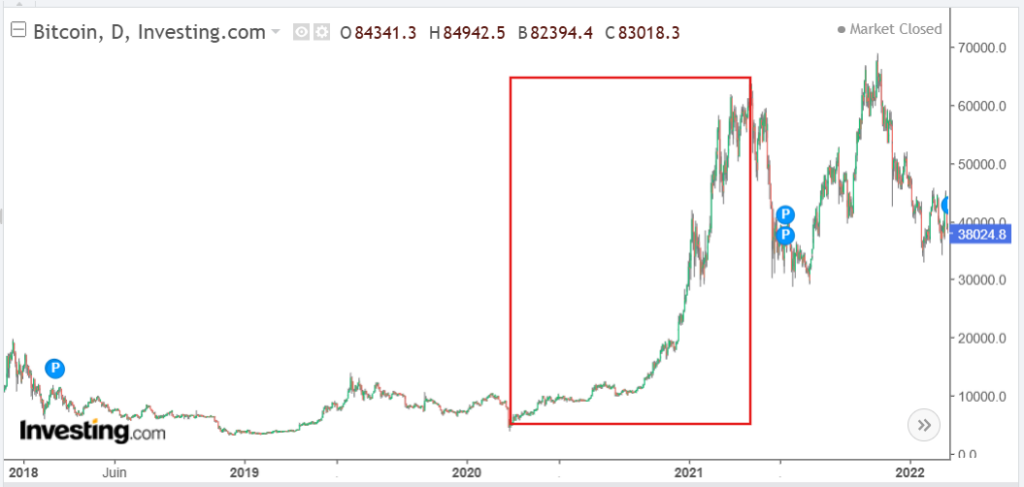
On this cycle, the participation of the institutionals was a key element, some companies that started to incorporate Bitcoin into their cash. The derivative markets, trading on margin and the expansion of exchange platforms have also contributed to the trend .
How long does a bull run last: Analysis of average durations for Bitcoin
To determine how long a bull run lasts more concretely, we can base ourselves on the exponential rises of the 5 major Bitcoin cycles:
- 2010 - 2011 cycle: approximately 2 months
- 2011 - 2013 cycle: about 3 months
- 2013 - 2014 cycle: about 2 months
- Cycle 2014 - 2017: About 9 months
- 2017 cycle - 2021: approximately 1 year and 1 month
We note that the duration of the climbs tends to lie down. Several factors can explain this trend:
- The adoption of bitcoin and cryptocurrency
- The increase in volumes, which makes markets more liquid and less sensitive to ultra-fast fluctuations
- The participation of institutional investors , which supports long -term prices
- The rehearsal of cyclical schemes linked to the Block Reward Halving (every 4 years approximately) which are less and less significant
In general, it becomes common to estimate that a bitcoin bitcoin market lasts between 12 and 18 months, with variability according to macroeconomic conditions and adoption speed.
How long does a bull run last: scientific approach and encrypted data
To adopt a more scientific perspective, historical data should be compiled in order to identify quantified trends. According to historical data available in CoinmarketCap , here are some quantitative elements:
- Over the past 10 years, Bitcoin has experienced an average cycle peak every 3 to 4 years
- The duration separating the major post-bull run hollow and the next Ath has varied between 2 and 3 years
- The longest bullish race has around 20 months (2020-2021)
The analysis of the distribution of returns on investment (King) during these periods highlights an exponential increase in the Bull Market phase, followed by a correction of up to 70 to 85 % for Bitcoin (and sometimes more for A ltc OOS) when the cycle switches to a lower market . The examination of these figures reinforces the idea that long -term resilience
How long does a bull run last: variables influencing the duration of a bull run
The question “ How long does a bull run ” also involves understanding the mechanisms that can shorten or extend a bullish cycle. Among the major elements:
- The economic situation : in period of high guiding rate and monetary tightening, speculation tends to calm down
- Technological advances (protocol updates, new features): for example, the arrival of staking on Ethereum stimulated the interest of investors in 2020 and 2021
- The role of social networks and influencers: the viral effect can accentuate the purchase frenzy
The more a market is exposed to exogenous factors, the greater the volatility, which can shorten or prolong the phase of high climb . On the other hand, when the market self-stands in a collective euphoria, the bull run can last longer than expected, until a major event (Macro factor, scandal, strict regulation) break the dynamics.
How long is a bull run lasts: identification of the end of a bull market
Advanced technical indicators
To locate the end of a bull run, several analysis tools based on the history of previous cycles make it possible to assess whether the Haussier market is coming to an end.
- The Rainbow Chart : This indicator uses colored strips to represent different phases on the market. When Bitcoin reaches the red zone ("maximum bubble territory"), this often means that the market is in overheating phase and that the correction is imminent.
- The Pi-Cycle Top Indicator : it is based on the crossing of two specific mobile averages (111 days and 350 days x2). Historically, this crossroads coincided with the top of the bitcoin bruise cycles, thus marking the end of the bull run .
- NUPL (net unrealized profit/loss) : This indicator measures the overall level of profit or unrealized loss of Bitcoin holders. A very high value (beyond 0.75-euphorically green zone) indicates an excess of optimism and an increased risk of lower reversal.
- Funding rats : These financing rates on term contracts indicate the positioning of traders on the market. When the funding rats become excessively positive, this means that too many investors are in a long position (lever -effect purchase), which can cause cascade liquidations and a brutal reversal.
- The Fear and Greed Index : This indicator synthesizes several market factors (volatility, volume, dominance, social feeling) to assess the psychological state of investors. When this index reaches extreme levels of "GREED" or "Extreme GREED" (above 80), this often means that the market is over-going and that a summit is close.
Fundamental signs and market feeling
In addition to technical indicators, certain fundamental and psychological elements often indicate that bull run has reached maturity:
- An exaggerated general optimism on social networks and the consumer media : when everyone talks about bitcoin and cryptocurrencies make the headlines of traditional economic newspapers, it is often an end of cycle signal. In previous bull run S, magazine covers announcing "Bitcoin at $ 100,000" often coincided with the summits.
- A massive influx of new inexperienced investors : when people without financial experience are starting to invest en masse, driven by the fear of missing the train ( FOMO ), this often indicates that the market is in its final euphoric phase.
- A saturation of the new projects market : at the end of the bullish cycle, too many new tokens without real utility floods the market, often supported by aggressive marketing strategies. This phenomenon was observed in 2017 with the ICOS and in 2021 with the memecoin .
- A volume of exchange in sharp decline : if, despite an even high price, the volumes begin to fall, this indicates a lack of new buyers, a sign that the dynamics run out of steam.
- Regulatory tightening or negative announcements : when a market reaches a summit, regulators often start to be more interested in it. Discomplete government announcements can speed up the end of a bull run .
How long does a bull run last: combine technical analysis and fundamental approach
investment decisions during a bull market, it is advisable to:
- Analyze macroeconomic trends (interest rate, inflation, monetary policies)
- Study the force of fundamentals : development team, adoption, liquidity
- Establish risk management strategies (stop-loss, staggered profits, diversification)
One of the ways to position yourself in a Bull Market is to apply the “Dollar-Cost Averaging” ( DCA ), by accumulating positions regularly rather than trying to time the market. In this way, the investor is less exposed to sudden variations and can smooth his purchase price.
How long does a bull run last: the limits of the fixed cycle hypothesis
It is often heard that the cryptographic market follows a four -year cycle, modeled on Bitcoin's Block Reward Halving However, this correlation has worked so far, but there is no certainty that it applies indefinitely. Major structural changes, such as the intervention of central banks or international legal reforms, could upset cyclic dynamics.
For example, faster than expected mass adoption could trigger a bull run , supported by considerable capital flows, or on the contrary a rapid krach if enthusiasm suddenly turns into panic. Institutions now having the capacity of Hedger their positions via derivative products, they can also put a brake on the exuberance of the market at any time .
How long does a bull run last: probable evolution of the next bull runS
The more time passes, the more demand and throughout the Crypto market evolves. Institutional investors, banks and even certain governments are now interested in this asset class. This dynamic helps to stabilize prices somewhat and also makes these assets increasingly subject to market manipulation of large funds through liquidity hunting by taking positions to influence the price of the markets. On the other hand, fierce competition between the protocols of smart contract S ( Ethereum , BNB Chain, Avalanche , etc.) feeds growth .
It is plausible that the future bull runlast longer than the first cycles, because the ecosystem is larger and more robust.
Synthetic response on the average duration of a bull run Crypto
By relying on historical data and on the experience of previous bull markets , we can respond nuancely:
- For Bitcoin, the average duration of an upward phase varies between 12 and 18 months. Nevertheless the exponential phases are shorter, even if they tend to smooth and lie over time.
- AltcOOS can experience often shorter climbs.
- The summit generally manifests itself by an ATH followed by a strong and rapid fall, signing the end of the bullish phase
However, it is essential to keep in mind that there is no rule engraved in marble. The fluctuations in the cryptocurrency are influenced by a set of complex factors: macroeconomics, regulations, collective feeling, technological innovation, etc.
Conclusion on how long a bull run lasts
The answer to the question “ how long a bull run ” lasts in cryptocurrencies depends on multiple components: price history, technical analysis, fundamental projects and macroeconomic environment.
Determining precisely the beginning and end of a bull market is a complex exercise. The rupture points are generally in massive euphoria, until a major summit is established. Experience shows that as soon as the supply of new buyers dries up or that an exogenous event disrupts general confidence, the correction starts, marking the passage in the lower market .
In summary, a real sustained climb called bull run can last between 2 months and more than a year depending on the growth phases observed on Bitcoin and the other crypto-active . They seem to lie down and smooth over time.
Investments in cryptocurrencies are risky. Crypternon could not be held responsible, directly or indirectly, for any damage or loss caused following the use of a property or service put forward in this article. Readers must do their own research before undertaking any action and investing only within the limits of their financial capacities. Past performance does not guarantee future results. This article does not constitute an investment advice.
Certain links of this article are sponsorship links, which means that if you buy a product or you register via these links, we will collect a commission on the part of the sponsored company. These commissions do not train any additional cost for you as a user and certain sponsorships allow you to access promotions.
AMF recommendations. There is no guaranteed high yield, a product with high performance potential implies a high risk. This risk taking must be in line with your project, your investment horizon and your ability to lose part of this savings. Do not invest if you are not ready to lose all or part of your capital .
To go further, read our pages legal notices , privacy policy and general conditions of use .

